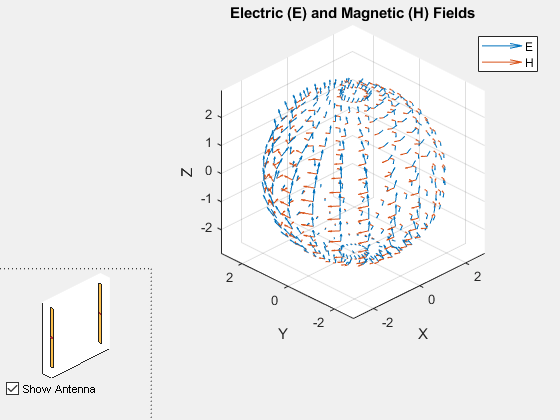EHfields
Electric and magnetic fields of antennas or embedded electric and magnetic fields of antenna element in arrays
Syntax
Description
[
calculates the x, y, and
z components of the electric and magnetic fields of an
antenna or array object at a specified frequency. The fields are calculated at
points on the surface of a sphere whose radius is twice that of the radius of a
sphere completely enclosing the antenna or array structure.e,h] =
EHfields(object,frequency)
EHfields(
plots the absolute values of the electric and magnetic field vectors along with
corresponding signed complex angles at the specified frequency. The
multiplication factor with absolute field value is +1 for positive and -1 for
negative complex angle. The fields are calculated at points on the surface of a
sphere whose radius is twice that of the radius of a sphere completely enclosing
the antenna or array structure.object,frequency)
EHfields(
plots the absolute values of the electric and magnetic field vectors along with
corresponding signed complex angles at specified frequency values and at
specified points in space. The multiplication factor with absolute field value
is +1 for positive and -1 for negative complex angle. Specify the points in the
Cartesian coordinate system.object, frequency, points)
EHfields(___,
plots the electric and magnetic field vectors using one or more name-value arguments in addition to
any of the input argument combinations in previous syntaxes. For example,
Name=Value)ViewField="E" displays only the electric field.
Use the ElementNumber and Termination
properties to calculate the embedded electric and magnetic fields of the antenna
element in an array connected to a voltage source. The voltage source model
consists of an ideal voltage source of 1 volt. The embedded pattern includes the
effect of mutual coupling due to the other antenna elements in the array.
Examples
Input Arguments
Name-Value Arguments
Output Arguments
Version History
Introduced in R2015a


